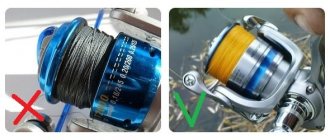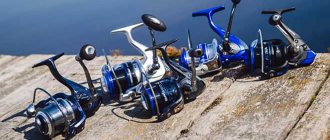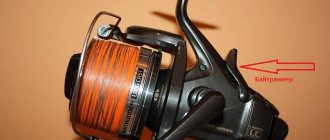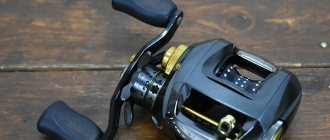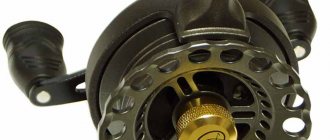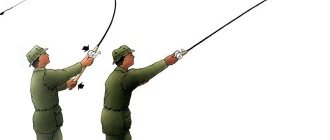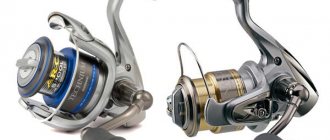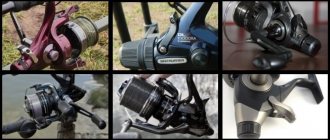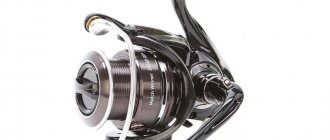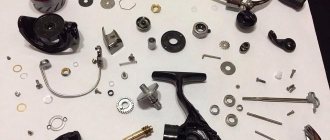The structure of inertia-free coils
Undoubtedly, in order to repair a coil you need to understand its structure and operating principle. Without exception, all inertia-free motors are assembled in the factory from the same type of units, which differ in size depending on the size of the mechanism. The main components of the device are the following parts and details of the product:
- frame;
- gear drive;
- brake clutch;
- rotor;
- reel seat support;
- rear direction switch;
- spool mounting rod;
- line layer with bow and roller;
- gear wheel with shackle.
Depending on the modification and purpose of the inertia-free grinder, or as fishermen also call it, a meat grinder, it can be supplemented with specific functionality inherent in a particular model.
Reel repair by a specialist
In difficult situations, in order to repair your favorite coil model, it is better to seek help from a specialist who already has dozens of repaired and correctly configured coils behind him. Masters who repair spinning reels have at their disposal a wide range of parts for products of any category, and therefore they will probably have something to replace the damaged element of your model. An experienced specialist can carry out not only the repair itself, but also lubricate the parts along the way and make precise adjustments of the main pair of gears.
How to disassemble a coil
Before planning to repair a fishing reel with your own hands, you should worry about the availability of the necessary materials and tools. For these purposes, the fisherman will need a small and medium-sized figured and flat screwdriver, pliers, tweezers, an awl, a soft and hard hair brush, an oil can, a piece of rags, as well as any type of cleaning agent containing alcohol and a special mineral oil intended for lubricating rubbing parts. device details.
It is convenient to carry out repair manipulations on a desk under a bright lamp with a white spectrum of light, on a backing made of a sheet of white paper, where small parts and connecting elements of the product will be clearly visible.
Disassembling the coil
The coil is disassembled according to the clear algorithm presented below. In the process of performing work, it is important to remember the order of the sequence of operations and scrupulously delve into the nuances that contribute to the accuracy of the work associated with the application of efforts to disconnect the threaded, bushing and locking connections of the elements and assemblies of the product.
- unscrew the nut of the brake system and the spool;
- remove the gears and washers located under the spool;
- remove the reel handle;
- unscrew the clamp nut in the mechanism;
- disassemble the rotor;
- dismantle the line-laying bow;
- dismantle the line guide latch mechanism;
- dismantle the line pulling roller;
- unscrew the screw of the reverse locking device;
- dismantle the switch lever;
- unscrew the plug screw;
- dismantle the plug;
- dismantle the wall.
After manipulating the parts and the body of the mechanism, we proceed to disassembling the line layer. It is not possible to construct an unambiguous algorithm for dismantling the parts of this element, due to significant differences in the design of the device in each version of the device. To ensure the reliability of the work, it is recommended to take step-by-step photographic recording of each operation performed, which today is quite accessible to the average person using a smartphone for these purposes.
Having recorded the disassembly process in photographs, after diagnosing and repairing the spinning reel, the fisherman can easily cope with its reassembly, bringing the product back to its original and functional form without errors.
In continuation of the article, we will look at a number of the most common problems with inertialess motors. These problems, which are not critical for the complete failure of the mechanism, can be associated both with defects in the materials of the product and with incorrect operation of the device. After all, the unfavorable conditions under which the meat grinder units operate, such as high humidity, abrasive sand particles and elementary dirt, certainly only have a negative impact on the operation of the unit as a whole, despite the scrupulousness and care with which it is treated.
But often, in fishing practice, even if the minimum rules for using inertia-free gear and regular maintenance of gears and bearings are observed, these troubles occur due to exhausted periods and resources exceeding the maximum capabilities of the components and parts of the product. The presented reel breakdowns should not confuse or unsettle the fisherman, because he should be able to put the device in order on his own, which is quite doable.
the fisherman needs to unscrew the reverse stop screw and remove the clutch. Then the unit is thoroughly cleaned of dirt and old lubricants, rinsing the cleaned surfaces with white spirit or solvent. After these manipulations and drying, fresh lubricant is added and reassembled. The functionality of the unit is restored to its original state.
Feeding a fishing line in a spiral when casting baits is one of the common problems in the operation of spinning gear, which can be solved in a fairly simple way, because the problem of incorrect operation lies in the clogging of the line roller. The essence of repairing a spinning reel when this problem occurs is to clean the line-laying mechanism assembly from dirt.
We invite you to read: Peculiarities of catching pike perch in summer
You will need to disassemble the line roller, following the recommendations presented in our article in previous chapters, and remove visible blockages with a brush, followed by washing the parts. Having lubricated the unit again, it is assembled sequentially and the device is used comfortably.
The problem in question threatens the loss of baits and is inherent in new, newly acquired mechanisms with a front position of the friction brake adjustment knob, during the so-called running-in of the reel on the first fishing trips. In devices of these designs, the locking nut is raised above the edge of the spool to a height of 1–2 mm.
When an angler reels in the rig, the line often gets caught on the nut and gets pulled under the edge of the spool, causing further tangling, deformation and line breakage. To eliminate incorrectness during winding, it is necessary to disassemble the spinning reel with the spool line, unscrew the clamping nut with the washers of the friction brake device and replace the factory felt pad with one of exactly the same size, only cut from thin plastic.
Noise inside the coil
Noise inside the mechanism body can indicate both minor and serious problems. If you hear extraneous sounds in the form of creaks or rattles, you should stop using the device until the essence of the problem is clarified. In any case, you will need to disassemble the spinning reel and visually inspect the transmission mechanism.
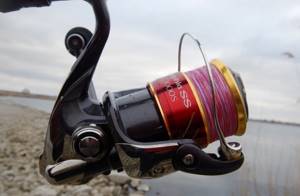
The problem is solved by mechanical cleaning and washing of the unit, followed by adding fresh lubricants. If deformation of parts and bearings is detected, which is most likely, they will need to be completely replaced with new spare parts.
Uneven winding of the fishing line is typical of old, long-life devices. The problem manifests itself in the form of a cone-shaped front laying of the cord during winding, or the same rear winding of the line onto the spool. If a conical arrangement is formed in the front part, the washer should be completely removed and removed from the main shaft of the part.
An option for repairing an inertia-free coil when winding with a cone upward is to add another washer to the shaft, compensating for the resulting wear. In both cases, the problem is eliminated in full, allowing you to wind the cord in the original, convenient for casting and originally designed factory style.
If the reel mechanism jams under load, then there is a high probability that the driven or drive gears will need to be replaced. To determine this, diagnostics will be required, which consists of disassembling the housing and visually inspecting the transmission mechanism to identify defective parts. The problem arises due to poor-quality material of gears and toothed shafts, as well as due to the long service life of the inertia-free drive.
We invite you to read: Catching bream with a float from the shore: secrets of big catches from professionals
Symptoms of the problem initially appear as light knocking inside the case, which subsequently turns into a limp when turning the handle, and then into its jamming and jamming even under minimal loads. It is worth considering that to fix the problem you will need spare parts that fit the parameters.
Damage on the sides of the spool is considered an unpleasant defect. Most often, a problem of this nature occurs as a result of shock loads on the body of the device, less often, and this problem is of a low-quality product, it is caused by the use of rigid cords. Microcracks, chips and nicks appear on the side of the spool.
Do-it-yourself repair of a spinning reel involves grinding the side of the spool and completely eliminating irregularities and roughness that lead to discomfort when casting and reducing the breaking loads of the line. For these purposes, sometimes it is enough to use fine abrasive sanding paper and a couple of minutes of easy-to-perform work.

Self-tightening of the clutch, to the great regret of the fisherman, should be classified as a malfunction in which it is not possible to repair a spinning reel. The problem often causes the line to break, especially if fishing is carried out on delicate gear with small diameter cords, suddenly appearing when the thread is released.
When fishing with heavy gear with thick cords, spontaneous clamping of the clutch can result in a breakdown of the transmission mechanism itself. An irreparable defect is the fate of poor-quality assembly of a cheap product, which, if possible, should be returned under the manufacturer’s warranty and a new product purchased.
An irritating defect during fishing is a defect in the device, in which the line-laying arm self-resets, which occurs in the cord rewinding mode. In one of the repair options, the problem can be resolved by tightening the clamping screws securing the bow. If tightening the mounting screws does not resolve the issue of incorrect operation, it is worth increasing the stiffness of the spring located under the device cover.
Cleaning the line roller should be perceived by the fisherman as a regular DIY repair of the reel after a certain period of use. The device is carefully disassembled into individual parts, which, with the exception of the bearing, are thoroughly washed in solvent to completely remove all dirt.
Damage to the reel spool
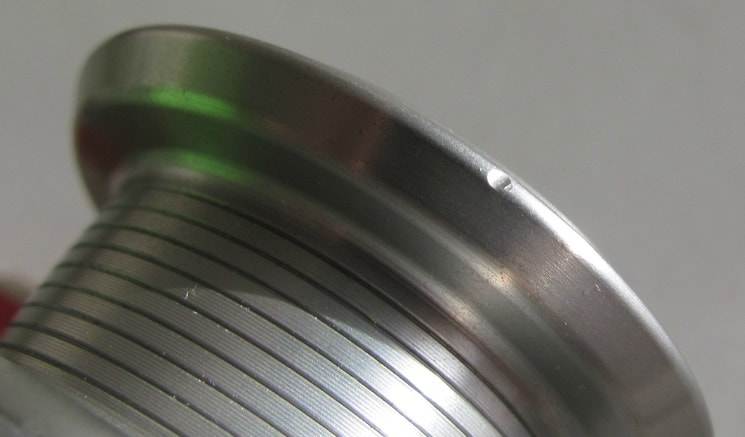
The presence of damage on the side can significantly affect the casting distance, and, naturally, only in a negative way. Also, due to scratches and unevenness of the spool, the fishing line itself often suffers, and its service life is reduced. Therefore, after detecting such defects, hurry to eliminate them by grinding and polishing the surfaces. In some modern reels, a special coating of a hard metal alloy is applied to the side of the spool, which it is advisable to leave in place.
Options for how a spinning reel works
Let's look at the principles of how a spinning reel works. When casting, the line slides through the side cheek of the stationary spool. Before throwing the tackle, the line layer snaps off to the side so as not to interfere with the flow of the line.
After turning the line guide bracket, the thread is placed on a roller, due to which the correct winding is carried out on the spool. Winding is carried out in two ways:
- turn to turn, however, in this case the upper horizons often fall down, preventing the line from being released at the time of casting;
- cross-shaped winding, the minus of which is that the line capacity of the spool is reduced.
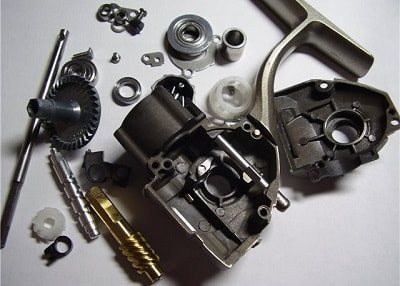
The principle of operation of a spinning reel lies in a special fastening of the spool, which is carried out in two ways: with an end button on the lock or rigidly. Rigid installation is preferable, since there is a possibility of changing the spool.
If an excessive load on the tackle is inevitable when fishing for trophy specimens, it is necessary to use a friction brake, which is adjustable. The adjustment can be made in the form of a thumb on the spool or a handle, which is more preferable.
We invite you to familiarize yourself with: Pattern of a cover for fishing rods and reels
There are various types of switches - slide or flag - due to them, the inertia-free coil, or rather its braking mechanism, operates. The most common are slide switches, which are located at the bottom or rear of the case.
Any reel has its own line winding profile, and to adjust the geometry, special washers are used, which can be included in the kit. If they are missing, you can decide on your own what to make the washer for the spinning reel from. It is important to remember that front and rear drag reels have different adjustments.
Line breaks under the clutch nut
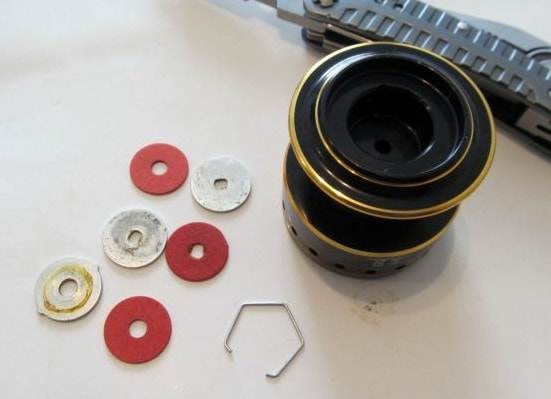
In reels with a front drag, the locking nut is located slightly above the edge of the spool, only about 1-2 mm. Because of this, the line often gets caught on the nut and gets under the edge, which leads to tangling and breaks. To eliminate this problem, you need to disassemble the coil, remove the nut and washers of the friction brake, and replace the felt spacer with a thin plastic spacer.
Care and prevention of breakdowns
Maintenance and prevention of breakdowns of inertia-free motors is not at all complicated.
In addition, it is worth ensuring that the mechanism is carefully transported, avoiding shocks and falls. When fishing, you shouldn’t put rods and reels on the sand, and also try to lower the device into the water as little as possible. Attention and careful attitude to the gear as a whole prolongs the operational potential of each element of the gun for a long time, including the inertia-free reel we examined.
Types of faults
- Breakdown of the main gear mechanism. Signs of rumbling, jamming, or jamming of the coil during operation. The reasons are wear of the axle and breakage of the teeth of the drive gear after the tested load. Most often it appears due to attempts to pull out the fishing line, working with the reel for purposes other than its intended purpose, and careless fishing.
- Malfunction of the drive gear axis. The reason is the loss of the bearing, which must be corrected by replacing the bushing with it.
- Self-tightening of the clutch. Reason: poor quality purchase. Initially, the manufacturer made a mistake, so such a breakdown promises the fisherman the purchase of a new reel.
- Stopping the movement of the spool, laying on the fishing line. The reason is the load is not suitable for this type of coil.
- Reducing casting distance. A sign of poor line laying. The reasons are the initial malfunction of the mechanism or the entry of foreign particles into it.
- Reverse system malfunction. Causes: thickening of the lubricant in the cold, foreign particles or deformation of the pressure springs.
- The roller is too noisy. Reasons: decreased lubrication of the bearing or foreign particles in the mechanism.
- Destruction of the fishing line due to damage to the spool. Causes of scratches, dents and other changes that lead to difficulty in the line coming off and its further abrasion.
- Rumble in the handle. Reasons: initial malfunction of the coil, wear of the handle or loosening of the clamping screw.
- Line break. Causes: Arbitrary clicking of the arc due to loss of elasticity of the return spring, wear of the components of the arc, or malfunction of the pusher.
Read: Spinning reel for twitching: the right choice
In conclusion, it should be said that no matter how unpleasant it may be to suddenly discover a malfunction of spinning reels, in most cases, a fisherman can fix the breakdown himself or turn to an experienced technician.
